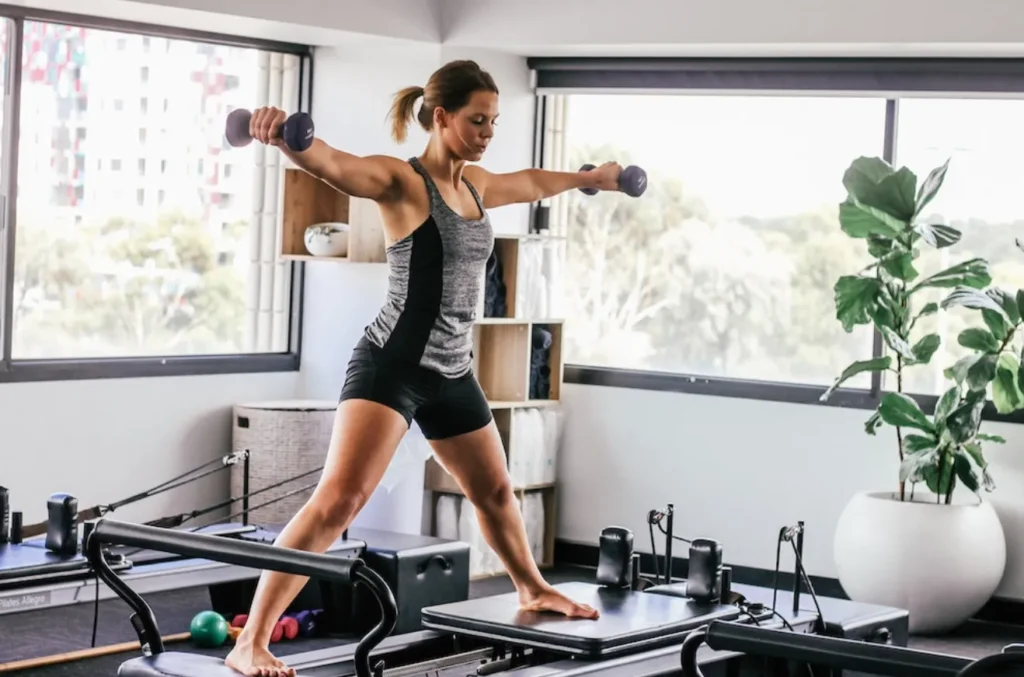In the realm of fitness and wellness, Pilates has cemented its place as a comprehensive approach to personal health, emphasising strength, flexibility, and mindful movement. Central to this practice is the use of specialised equipment designed to enrich the Pilates experience, with the pilates reformer being one of the most iconic and transformative pieces of apparatus. This guide will explore the benefits and intricacies of the Pilates reformer, helping fitness enthusiasts and novices alike to harness its potential for enhancing core strength and overall physical conditioning.
What is a Pilates Reformer?
The Pilates reformer is a sophisticated machine that provides a dynamic and versatile platform for a diversity of exercises. Its structure consists of a carriage that moves on wheels within a frame, connected to one end by a set of springs that provide adjustable resistance. The user can perform movements while lying, sitting, standing, or even kneeling on the carriage, making it an adaptable tool suitable for varying fitness levels and objectives.
Components of a Pilates Reformer
Understanding the components of the reformer is essential for leveraging its full potential. The machine includes a foot bar against which exercises are performed, shoulder blocks to keep you stable, and long straps with handles to engage the arms and legs. Adjusting the springs and altering positions can significantly modify the challenge and intensity of each exercise.
Core Strength and the Pilates Reformer
At the heart of Pilates is the emphasis on core strength. The reformer facilitates a unique environment where core muscles are consistently engaged. By maintaining stability on the moving carriage and executing controlled movements, you effectively train the muscles of the abdomen, lower back, hips, and pelvis — known collectively as the powerhouse.
Benefits Beyond the Core
While the most significant advantage of the reformer is its core-centric approach, the benefits extend further. It enhances flexibility, improves posture, increases muscular endurance, and fosters efficient movement patterns. Additionally, the capability to perform a broad range of movements can lead to improved coordination and balance.
Pilates Reformer Exercises
Reformer Pilates consists of a multitude of exercises that can be categorised based on the targeted muscle groups and the desired outcomes. Beginners often start with fundamental movements focusing on leg and arm work, such as footwork and arm circles, which introduce the concepts of resistance and alignment. Intermediate and advanced users may progress to more complex sequences that incorporate twisting and overhead motions, challenging stability and control.
Customising Your Pilates Reformer Workout
One of the most significant advantages of the Pilates reformer is the ability to customise workouts. The adjustable springs allow users to dictate the resistance level, accommodating both rehabilitation needs and athletic training. Ergonomic modifications can be made by altering the gear bar settings, changing foot bar positions, and using different accessories to support or advance specific exercises.
Using the Reformer for Rehabilitation
Reformer Pilates is not just for the fitness-savvy. Its application in rehabilitation is noteworthy, with the machine’s design lending itself well to those recovering from injuries or managing chronic conditions. The controlled, low-impact movements make it an ideal choice for safely rebuilding strength and mobility.
Integration into a Holistic Fitness Regime
Fusing Pilates reformer workouts into a holistic fitness regime can bridge gaps left by other forms of exercise. The precise, mindful movements complement high-intensity exercises and support athletic training by promoting recovery, flexibility, and fluidity of movement.
Choosing the Right Reformer
Selecting the appropriate Pilates reformer is critical to ensure safety and maximise the effectiveness of your workouts. High-quality equipment will offer smooth transitions, durable construction, and a range of adjustability options. Attending classes or seeking advice from professional Pilates instructors can help in making an informed decision.
Purchasing vs Studio Access
While access to reformers in a Pilates studio is standard, investing in a personal Pilates reformer allows for convenience and the flexibility of training in your own space. The decision to purchase or use studio equipment should consider factors such as cost, space, and the frequency of intended use.
Advice for Beginners
For beginners eager to integrate the reformer into their workouts, starting with guided instruction is vital. Certified Pilates instructors can introduce foundational techniques and ensure exercises are executed correctly. Building a foundational understanding of how to use the reformer with proper form minimises the risk of injury and paves the way for optimal results.
Advancing Your Pilates Reformer Practice
As proficiency in using the reformer grows, so does the potential to broaden your exercise repertoire. Advanced users can challenge themselves with exercises that demand greater coordination, strength, and balance, often integrating props such as resistance bands or Pilates rings.
Conclusion: A Journey of Core Mastery
The Pilates reformer offers a compelling avenue for mastering core strength and propelling overall fitness. It represents a significant investment in one’s health and wellbeing, with the versatility to adapt to varying needs and goals. Whether you’re a seasoned practitioner or a newcomer to Pilates, the reformer provides a supportive yet challenging environment in which to cultivate a stronger, leaner, and more balanced physique.
As individuals continue to seek innovative and effective ways to enhance their fitness journey, the pilates reformer stands out as a sophisticated and transformative tool, embodying the essence of Pilates and its timeless pursuit of physical and mental wellness. Embracing it within your fitness routine could be the key to unlocking a new level of core strength and conditioning.

